 Last week’s Safety Net column on Linn Energy (Nasdaq: LINE) and its 20% yield resulted in a lot of requests for other 20%-plus yielders.
Last week’s Safety Net column on Linn Energy (Nasdaq: LINE) and its 20% yield resulted in a lot of requests for other 20%-plus yielders.
A few months ago, it would have been very difficult to find a stock with a yield that high. However, the sell-off in oil and oil stocks has created numerous beaten-down stocks that now yield over 20%.
One of them is the preferred shares of Miller Energy Resources (NYSE: MILL).
The preferreds are the Miller Energy Resources 10.75% Series C Cumulative Redeemable Preferred Stock (NYSE: MILL-PC) and Miller Energy Resources 10.5% Fixed Rate/Floating Rate Cumulative Redeemable Preferred Stock (NYSE: MILL-PD).
[ad#Google Adsense 336×280-IA]The Series C shares yield 29.1% and the Series D shares yield a whopping 32.8%.
That’s because both stocks, which have a par value of $25, are trading below $10 and $8, respectively.
A preferred stock is like a hybrid between a bond and a stock.
It typically has a high dividend yield, which usually makes the stock less volatile – although clearly not in this situation.
The stocks can have maturity dates or callable dates.
At those times, shareholders will be paid the par value (usually $25) for their shares, no matter what they paid for them.
In the event of a bankruptcy, preferred shareholders get paid after bondholders, but before common stockholders. Additionally, if a company pays dividends to common shareholders, the owners of the preferred stock must be paid first. And if the dividend is ever not paid and the preferreds are cumulative, that means the company must pay all of the owed preferred dividends before it can pay common shareholders.
All of that out of the way, Miller Energy’s preferreds are priced as if the dividend is in serious jeopardy. Let’s see if it is.
Is Something Burning?
The company loses money, but we’re not overly concerned about that since much of those losses come from non-cash expenses. In fact, in the first six months of fiscal 2015, which ended in October, Miller Energy generated $25.5 million in cash flow from operations.
The problem is they have to spend so much on capital expenditures that free cash flow is negative. Through October, Miller Energy burned through $52.7 million in free cash flow. And Wall Street doesn’t expect that to change any time soon.
Low oil prices certainly aren’t going to help, although the company’s oil is 90% hedged in the range of $90 per barrel.
It has about $15.5 million in cash and paid out approximately $6.4 million in preferred dividends in the first half of the fiscal year.
The only way it can pay the dividends is by dipping into its depleting cash hoard, borrowing more money or raising capital. There are fears that the smaller independent oil companies will not be able to continue to borrow money as they have in the past. Banks may be concerned that the companies cannot generate sufficient cash flow when oil prices are low to pay back the loans.
On the company’s earnings conference call last week, new CEO Carl Geisler emphasized that the preferred dividend is “sacrosanct.”
That’s somewhat reassuring, although readers of this column know not to trust a CEO at his word. Seadrill Limited (NYSE: SDRL) reinforced that lesson when it eliminated the dividend three months after the CEO said the dividend was safe through mid-2016.
If this were the dividend of a common stock, I’d have to give it an “F.”
 But preferreds are a different animal. Companies are less likely to cut preferred dividends.
But preferreds are a different animal. Companies are less likely to cut preferred dividends.
Nevertheless, they’ll have to come up with the money from somewhere to pay it.
And if oil prices stay low, they may find it difficult to obtain the necessary financing.
As long as Miller Energy can obtain funds, I’m confident the dividend will be paid.
But whether it can access that capital is the big question.
The market is telling us there is some (perhaps more than some) risk of a dividend cut.
I agree.
Dividend Safety Rating: C
— Marc Lichtenfeld
[ad#DTA-10%]
Source: Wealthy Retirement


